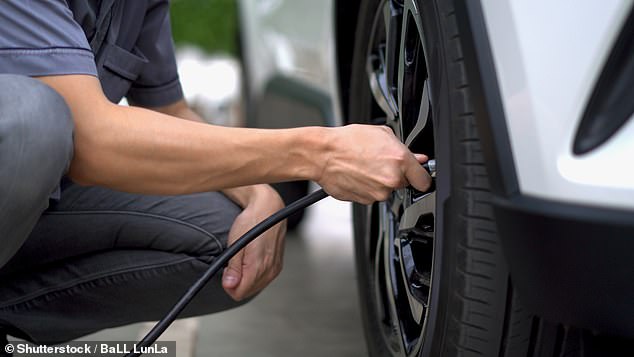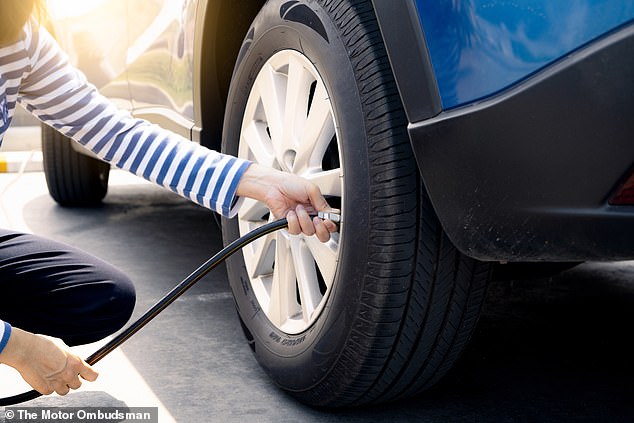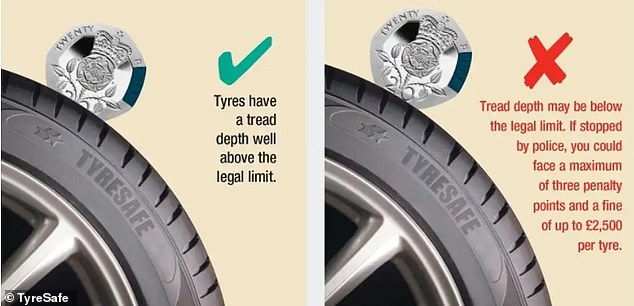Drivers ‘waste £112 million a year’ by making a mistake with cars that takes minutes to fix
Motorists in Britain throw away hundreds of millions of pounds every year by making one simple mistake with their car, which is repaired within minutes, according to a new study.
Motorists who drive with under-inflated tires are reportedly wasting at least £112 million a year by burning the rubber faster – and inevitably increasing their fuel bills in the process, according to The Motor Ombudsman.
The British Tire Manufacturers’ Association (BTMA) and charity TyreSafe estimate that 57 percent of cars in Britain have tire pressures that are 10 percent lower than what is recommended by car manufacturers.
With approximately 33 million motorcycles on the road, this equates to approximately 19 million with underperforming rubber.
The British Tire Manufacturers’ Association estimates that 57% of cars in Britain have tire pressures that are 10% below the recommended level. As such, drivers are destroying their rubber much faster than they should, costing at least £112 million in replacement tyres.
The most common tire size for cars in Britain is 16 inches. On average, the cost to replace one is £85, the BTMA says.
If drivers do not check that the tires are inflated to the manufacturer’s recommended pressure, this would amount to an avoidable annual loss of 1.3 million tires, says the ombudsman.
With the British reportedly burning through rubber much faster than they should, the bill for accelerated tire wear is at least a whopping £112 million a year.
And that’s if just one tire is underinflated; If every corner of the car comes under the suggested pressure, it could cost drivers four times as much in prematurely destroyed rubber.
There is also an additional financial pressure on fuel consumption.
Under-inflated tires ultimately increase rolling resistance and therefore place additional demands on your car’s engine. The result is that it has to work harder when you accelerate.
Philip Gomm, spokesperson for road safety organization RAC Foundation, explains: ‘Incorrectly inflated tires can be bad for safety, but also affect fuel consumption.
‘If they are too low, fuel consumption is reduced by as much as ten percent due to the extra resistance of the road.’

Experts warn that underinflated tires can reduce a vehicle’s efficiency by as much as 10%. For the average family car owner, this could mean £137 worth of fuel wasted every year
For a petrol family car returning 40 miles per gallon (mpg), the annual fuel cost (based on the current price of unleaded petrol at 146.4p, according to RAC Fuel Watch) to cover the national average of 7,400 miles per year is £ 1,231.
But because under-inflated tires reduce fuel efficiency by up to 10 per cent, this cuts economy to 36mpg and would increase the annual fuel bill by £137 to £1,368, based on This is Money’s calculations.
Continental Tires estimates that every 4.3 PSI (Pounds per Square Inch) below the recommended pressure results in an additional 1.5 percent fuel economy.
One of the main reasons drivers make this mistake is because more than a third don’t feel confident inflating their tires.
Shockingly, some 37 percent of respondents in a survey of 1,000 drivers said they are unsure how to pump air into their tires – and more than half (51 percent) don’t know how to correctly measure tread depth to to ensure that the rubber stays in place. is above the legal minimum requirement of 1.6 mm.
Bill Fennell, chief ombudsman, said: ‘Under-inflated tires pose a number of risks and costs.
‘Avoiding unnecessary costs is especially relevant given the current financial pressures on the nation’s motorists.’
Stuart Lovatt, chairman of TyreSafe, added: ‘Under-inflated tires compromise the performance of tires and vehicles, and can ultimately cost drivers and vehicle owners a lot of money, as the Motor Ombudsman investigation has clearly shown.
‘We strongly urge motorists to observe the pressure levels recommended by vehicle manufacturers. This is because they have been calculated with absolute precision to ultimately ensure the safety of vehicle users on the road.”

Below are our four quick tips for tire pressure, including how often to check it
Four quick tire pressure tips for drivers
1. How often should you check the tire pressure?
It is advisable to check your tire pressure at least once a month and before making long journeys or transporting heavy loads. Be sure to check the spare tire if you have one with you.
2. Where can I find the correct tire pressure for my vehicle?
The correct tire pressure for your car can usually be found on a sticker on the driver’s door frame (when the door is open), on the inside of the fuel filler flap or in the owner’s manual if no sticker is present.
3. Check the pressure before departure when the tires are cold
If possible, check your tires while they are cold.
4. In addition to checking tire pressure, perform other tire maintenance
When checking your tires, also look for any cracks, tears or ‘bumps’ in both the sidewall and tread. If there are signs of damage, have the tires inspected at a garage and replaced if necessary.
5. Is there sufficient tread on the tires?
Make sure you have at least 1.6 mm tread depth across the entire width of the tire. This is easily checked using a 20 cent piece by placing the coin in the band groove. If the outer band of the coin is not visible, your bands are legal. But if you can see the tire, they are probably illegal and need to be replaced.

As TyreSafe shows here, using a 20 cent coin is a simple way to check whether the depth of your car tires meets legal requirements
Some links in this article may be affiliate links. If you click on it, we may earn a small commission. That helps us fund This Is Money and keep it free to use. We do not write articles to promote products. We do not allow a commercial relationship to compromise our editorial independence.
